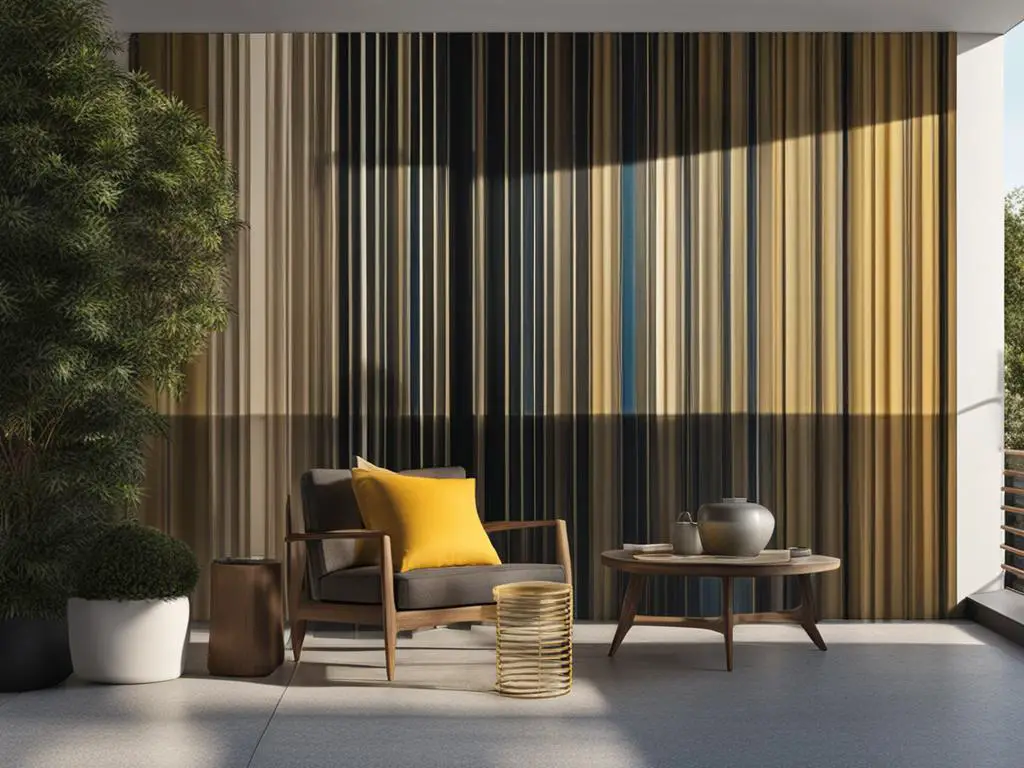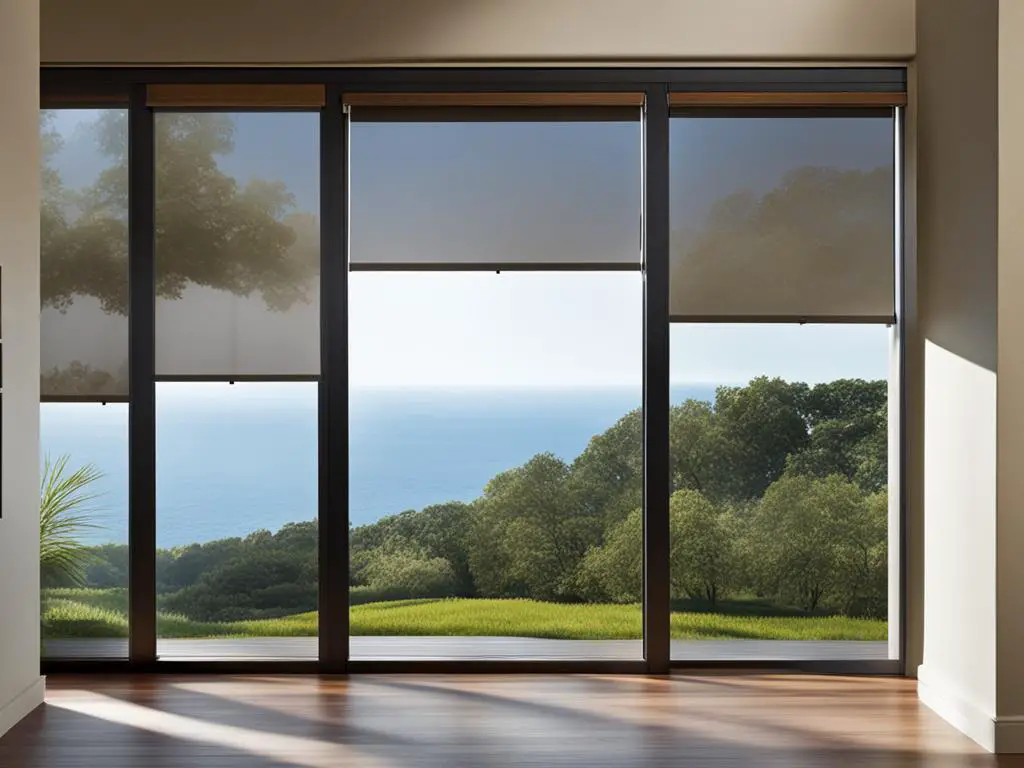When it comes to choosing the right solar shades for your space, factors such as light control, privacy, and maintaining the view are crucial. Solar shades with different opacity percentages, specifically 1% and 3%, offer distinct advantages in terms of light control and visibility. Understanding the differences between these percentages will help you make an informed decision about which fabric is best suited for your needs.
Key Takeaways:
- Consider factors such as sun control, insulation, privacy, and maintaining the view when selecting solar shades.
- The openness factor plays a significant role in determining the level of light control and view you desire.
- Solar shades with 1% opacity offer increased privacy, while shades with 3% opacity provide better visibility.
- Color choice in solar shades affects light control, glare reduction, and view preservation.
- Choose the optimal solar shades based on the specific needs of each space.
Key Factors to Consider When Selecting Your Solar Shade Fabric
When it comes to choosing the right solar shade fabric, there are several key factors that should be taken into consideration. These factors include sun control, insulation, privacy, and maintaining the view. Let’s explore each of these factors in detail:
Sun Control
Solar shades are designed to protect you and your space from harmful UV rays. The right fabric can significantly reduce the amount of heat and glare that enters the room, creating a comfortable and enjoyable environment. Look for fabrics that have a high UV protection rating to ensure optimal sun control.
Insulation
Solar shades also play a role in insulation, helping to regulate the temperature of your space and reduce heating and cooling costs. The right fabric can act as a barrier, preventing heat from escaping during the winter months and blocking heat from entering during the summer. Consider fabrics with insulation properties to maximize energy efficiency.
Privacy
Privacy is an important consideration when selecting solar shade fabric. Depending on your needs, you may want a fabric that offers complete privacy or one that allows some visibility while still providing a level of privacy. Consider the opacity of the fabric and choose one that aligns with your privacy preferences.
Maintaining the View
While solar shades provide sun control and privacy, it’s also important to maintain the view outside. The right fabric should allow you to enjoy the scenery while still providing the necessary protection. Look for fabrics that offer a balance between sun control and maintaining the view.
By considering these key factors – sun control, insulation, privacy, and maintaining the view – you can make an informed decision when selecting your solar shade fabric. Remember to choose a fabric that aligns with your specific needs and preferences to create a comfortable and inviting space.

[Image Description: A visually appealing and relevant image depicting solar shade fabric. The image showcases different fabric samples in various colors and textures, highlighting the aesthetic appeal and versatility of solar shades. The alt attribute describes the image as ‘solar shade fabric’.]
Understanding the Openness Factor
The openness factor is an essential element to consider when choosing solar shades. It refers to the measurement of how tightly the fabric weave is designed in the shades. The openness factor directly impacts light control and view preservation in your space.
A lower openness factor indicates a tighter weave, creating less space for light to pass through. This results in increased privacy and reduced visibility from the outside. If you value privacy and want to limit the amount of light entering your space, solar shades with a lower openness factor are recommended.
On the other hand, a higher openness factor signifies a looser weave with more openness. This allows for increased visibility and a better view of the outside world. Solar shades with a higher openness factor provide a balance between light control and maintaining a clear view.
Understanding the openness factor is crucial in selecting the right solar shades for your needs. Consider the desired level of light control and privacy, as well as the importance of maintaining a clear view when making your decision.
Differences Between Solar Shades with 1% and 3% Opacity
When it comes to choosing solar shades, even a slight difference in opacity can have a significant impact on light control, visibility, and glare reduction. Let’s explore the distinctions between solar shades with 1% and 3% opacity, and how they can influence your space.
Light Control:
A solar shade with 1% opacity offers maximum light-blocking capabilities. It significantly reduces the amount of sunlight entering the room, providing excellent light control and ensuring a darker environment when desired. On the other hand, solar shades with 3% opacity still offer good light control while allowing a bit more natural light to filter through, creating a balance between brightness and shade.
Visibility:
Privacy is an essential consideration when selecting solar shades. A 1% opacity fabric provides greater privacy by limiting visibility from the outside. The tighter weave of the fabric prevents anyone from seeing into your space, making it ideal for rooms where privacy is a top priority. In contrast, solar shades with 3% opacity offer decent privacy while allowing for some visibility, allowing you to maintain a connection with the outside world.
Glare Reduction:
Glare can be a nuisance, especially in rooms with high sun exposure. Solar shades with 1% opacity excel at reducing glare, as they effectively block more sunlight from entering the space. The darker fabric colors typically used with 1% opacity shades further aid in glare reduction. Conversely, solar shades with 3% opacity also provide glare reduction benefits, although to a slightly lesser extent. The amount of glare reduction offered depends on the specific fabric color chosen.

| Features | Solar Shades with 1% Opacity | Solar Shades with 3% Opacity |
|---|---|---|
| Light Control | Excellent | Good |
| Visibility | Minimal | Moderate |
| Glare Reduction | High | Moderate |
Optimal Solar Shades for Light and Privacy in Different Spaces
The choice of solar shades for different spaces depends on the desired level of light control and privacy. In a living room with a great view, 5% openness factor fabric is a popular choice to maintain the view while reducing glare. In a dining room where privacy is a priority, a 3% or even 1% openness factor fabric would be more suitable, ensuring privacy both day and night. It’s important to consider the specific needs of each space when selecting the optimal solar shades.
| Space | Desired Light Control | Preferred Openness Factor | Privacy |
|---|---|---|---|
| Living Room | Great view | 5% openness factor | Reduced glare |
| Dining Room | Privacy priority | 3% or 1% openness factor | Ensured privacy day and night |
When selecting solar shades for your living room, consider the stunning view and the need for light control. Solar shades with a 5% openness factor allow you to enjoy the outside scenery while reducing glare. This fabric choice strikes a perfect balance between maintaining privacy while still letting natural light in.
In the dining room, privacy becomes a priority. Solar shades with a 3% or 1% openness factor are ideal for ensuring privacy both during the day and at night. Whether you’re having an intimate dinner or hosting a gathering, these shades provide the darkness you desire without sacrificing style.
Remember, each space has its own unique requirements when it comes to light control and privacy. By selecting the optimal solar shades, you can create a comfortable environment that aligns perfectly with your needs.

Considerations for Color in Solar Shades
The color of solar shades can have a significant impact on light control, glare reduction, and view preservation. Choosing the right color can enhance the functionality and aesthetics of your space.
Light reflection: Lighter colors have higher reflectivity values, effectively bouncing off more thermal energy and reducing glare. This can create a more comfortable and visually pleasing environment.
Glare reduction: The color of solar shades plays a role in reducing glare. Darker colors tend to absorb more heat, which can help in reducing glare. By minimizing harsh glares, you can enhance visual clarity and increase productivity in spaces like offices or study areas.
View preservation: Darker colors in solar shades provide better view preservation. They offer a clearer view from inside while still providing protection from the sun’s rays. This is particularly useful if you have a scenic view outside that you don’t want to obstruct.
Choosing the right color for your solar shades depends on the desired outcome for each specific space. Consider the amount of natural light, the existing color scheme, and the purpose of the room when selecting the color of your solar shades. By taking these factors into account, you can create a comfortable and visually appealing environment while maintaining the functionality of your space.
Conclusion
When it comes to choosing between solar shades with 1% and 3% opacity, several factors need to be considered, including light control, privacy, and view preservation. Each option has its own advantages, and the decision ultimately depends on the specific requirements of your space.
If you value maximum privacy, opting for solar shades with 1% opacity is recommended. These shades block more light and provide a higher level of privacy, making them ideal for areas where discretion is essential.
On the other hand, if maintaining a clear view is a priority, solar shades with 3% opacity offer a great balance of light control and visibility. These shades allow in more natural light while still providing adequate privacy, making them suitable for spaces where both factors are important.
By selecting solar shades with different opacity percentages, you can achieve the optimal combination of light control and privacy for your specific needs. Whether you prefer to bask in natural light while still enjoying privacy or want to maximize privacy without compromising your view, there is a solar shade solution available.
FAQ
What factors should I consider when selecting my solar shade fabric?
When selecting a solar shade fabric, consider factors such as sun control, insulation, privacy, and maintaining the view.
What is the openness factor in solar shades?
The openness factor is a measurement that indicates how tightly the fabric weave is designed in solar shades.
What are the differences between solar shades with 1% and 3% opacity?
Solar shades with 1% opacity block more light and provide greater privacy, while shades with 3% opacity offer good light control and slightly more visibility.
What are the optimal solar shades for light and privacy in different spaces?
The optimal solar shades depend on the specific needs of each space, with 5% openness factor fabric popular in living rooms and 3% or 1% openness factor fabric suitable for dining rooms.
How does the color of solar shades impact light control and view preservation?
Lighter colors have higher reflectivity values, reducing glare, while darker colors provide better view preservation and reduce glare.
Which solar shade opacity is best for maximizing light control and privacy?
The choice between solar shades with 1% and 3% opacity depends on the desired level of light control, privacy, and view preservation for each space.



